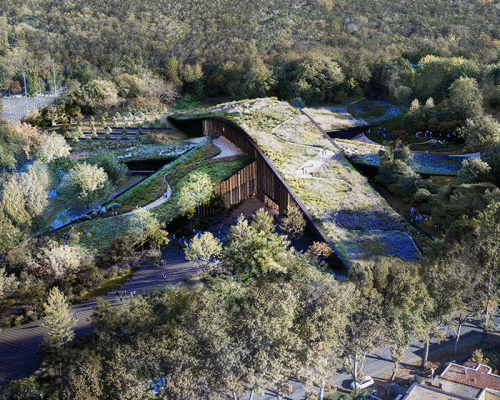a global roundup of museums
Museums offer a singular way to experience architecture as a living record. Across the world, new cultural institutions and thoughtful transformations continue to shape how we engage with artwork, historical artifacts, and civic life. In this context, architecture becomes a means of orientation, framing memory and revealing histories. This year, major museum projects have been unveiled and completed. From subterranean expansions to open-air installations, the physical frameworks of these institutions reflect shifting curatorial values and public expectations. Some buildings stretch across city streets or rise from the forest floor, while others embed themselves carefully within existing heritage, expanding through deliberate restraint.
To celebrate International Museum Day, held on May 18th each year, designboom rounds up a selection of recently unveiled and anticipated museums. These projects move beyond the boundaries of the traditional gallery, inviting new modes of participation and perception. What emerges is a deeper consideration of structure and story — each museum offers its own response to the evolving role of architecture in public life.
The Frick Collection, New York, NY | image © Nicholas Venezia
Hungarian Natural History Museum
In Debrecen’s Great Forest, the Hungarian Natural History Museum designed by Bjarke Ingels Group with Vikár és Lukács Építész Stúdió, Museum Studio, and TYPSA rises from the ground in a trio of landscaped ribbons that weave through the trees. The mass timber structure is partially embedded into the terrain, its charred wood facade drawing material cues from the forest while supporting the ecological rhythms of the site.
Conceived as both architecture and landscape, the building folds together exhibition halls, public spaces, and research facilities in a continuous spatial flow, anchored by a central atrium and topped with native-planted green roofs. Viewed from above, the museum appears as an extension of the forest floor, its geometry clear but softened by its interaction with the natural surroundings. Passive design systems and on-site renewables help stabilize the interior climate, reinforcing a broader vision of cultural and environmental restoration.
Hungarian Natural History Museum, Debrecen, Hungary | visualization © BIG
FENIX MUSEUM OF MIGRATION
Fenix, the new museum of migration designed by MAD and led by architect Ma Yansong, has opened its doors within a transformed 1923 warehouse in Rotterdam’s Katendrecht district. The project anchors itself in a place once defined by departures, reimagining the monumental port structure as a civic space where personal histories and collective memory converge. At its core rises the Tornado, a spiraling double-helix staircase that cuts through the historic building and culminates in a rooftop observatory. This gesture of upward motion becomes a sculptural expression of passage, both physical and symbolic.
Inside, exhibitions unfold across immersive installations and contemporary artworks, interweaving photography, found objects, and oral histories to chart the human experiences of migration. At ground level, a freely accessible public plaza with food offerings and performances reflects the city’s multicultural spirit. For Ma Yansong, Fenix is at once an architectural milestone and a vessel for encounter and memory. It is an idea brought to life as visitors ascend through light, shadows, and shared stories.
Fenix Museum of Migration, Rotterdam, The Netherlands | image © designboom
Shenzhen Science & Technology Museum
In Shenzhen’s Guangming District, the newly opened Science & Technology Museum by Zaha Hadid Architects stands as a bold focal point at the edge of the city’s emerging Science Park. The spherical structure anchors the site with a deep blue stainless-steel skin that subtly shifts in color and reflects the sky. Terraces unfold to the west, connecting the building to the park and extending the experience of the galleries outdoors.
A vast central atrium serves as the spatial core, with exhibition spaces branching outward in layered, shifting planes that invite movement and exploration. The design merges civic architecture with sustainable ambition, incorporating passive ventilation, solar energy, and water recycling while using a digital twin to navigate its intricate geometry. Designed as a cultural and research hub, the museum brings together education and technology into a single fluid form.
Shenzhen Science & Technology Museum, Shenzhen, China | image courtesy Zaha Hadid Architects
the frick Collection
After nearly five years of renovation, The Frick Collection has reopened in New York with a renewed sense of architectural continuity, guided by Selldorf Architects in collaboration with Beyer Blinder Belle. The design navigates the delicate balance between preservation and intervention, with subtle alterations that honor the original 1914 Carrère and Hastings mansion while expanding its spatial and programmatic possibilities.
Key additions include the Ronald S. Lauder Exhibition Galleries, a subterranean auditorium, and public access to the residence’s second floor, where private rooms have been carefully restored. The architecture is thoughtful in tone and quiet in execution, from the oak floors to the glass-and-bronze bridge connecting the museum to the Frick Art Reference Library. With expanded facilities and newly integrated sightlines, the building deepens its role as both a cultural landmark and a site of ongoing scholarship.
The Frick Collection, New York, NY | image © Joseph Coscia Jr.
British Museum, Western Range galleries
Lina Ghotmeh—Architecture has been selected to lead the redesign of the Western Range galleries at London‘s British Museum, marking a defining chapter in the institution’s ongoing Masterplan. Known for her context-driven and materially sensitive approach, Ghotmeh proposes a reconfiguration that responds both to the museum’s architectural fabric and its layered historical collections. Her design draws from archaeological thinking, using excavation as metaphor and method, particularly in the reimagined space for the Mausoleum of Halicarnassus.
The project, slated for completion in 2026, will unfold through a multidisciplinary collaboration with specialists in conservation, engineering, and curatorial practice. As a result, the Western Range will become a renewed site of encounter — architecturally measured and intellectually charged — where history is at once preserved and reinterpreted.
Western Range galleries at the British Museum, London, England | visualization courtesy Lina Ghotmeh
Los Angeles County Museum of Art (LACMA)
As construction on the David Geffen Galleries nears completion, the Los Angeles County Museum of Art prepares for a transformative chapter shaped by Peter Zumthor’s sweeping concrete design. Elevated above LA‘s Wilshire Boulevard, the new building stretches across both sides of the thoroughfare, reorienting the museum’s campus with a fluid, sculptural presence.
Accessed by floating stairs and elevators, the structure will gradually open in phases beginning in 2025, offering new public spaces, shaded plazas, and the East West Bank Commons beneath the elevated galleries. Educational and cultural programs will be anchored by the W.M. Keck Education Center and the Steve Tisch Theater, while large-scale works by Mariana Castillo Deball, Sarah Rosalena, and others will be embedded across the 3.5-acre landscape. As LACMA approaches its full reopening in 2026, the architecture sets the stage for renewed engagement with art and the city itself.
Los Angeles County Museum of Art, Los Angeles, California | image via @LACMA
TEAMLAB PHENOMENA
Set to open in April 2025 within Abu Dhabi’s Saadiyat Cultural District, teamLab Phenomena introduces a permanent space for immersive, interactive installations that evolve in real time. Conceived by the Tokyo-based art collective and designed in collaboration with MZ Architects, the 17,000-square-meter structure is shaped around teamLab’s philosophy of environmental phenomena, where artworks emerge through changing conditions of light, air, and water. The architecture facilitates a fluid relationship between visitor, artwork, and atmosphere, transforming each encounter into a distinct sensory event. As part of Abu Dhabi’s cultural vision, the venue invites open-ended exploration across art and technology while positioning itself as a catalyst for continuous discovery.
teamLab Phenomena, Abu Dhabi, UAE | visualization courtesy © teamLab
Museo Egizio, Gallery of the Kings
At Turin’s Museo Egizio, OMA has completed the renovation of the Gallery of the Kings as part of its broader reimagining of the institution, set for completion in 2025. Working with Andrea Tabocchini Architecture, the team transformed a once shadowed interior into a luminous sequence of vaulted halls, where natural and artificial light reflect off aluminum walls to heighten the presence of monumental statuary.
The design draws on ancient Egyptian associations between light and divinity, aligning spatial experience with curatorial intent. Visitors now enter through a darkened threshold before emerging into two galleries that restore the architectural clarity of the 17th-century building and stage the statues of Karnak in a newly choreographed order. The interplay of material and history offers a renewed encounter with the museum’s core collection, shaped by light and grounded in time.
Gallery of the Kings, Museo Egizio, Turin, Italy | image © Marco Cappelletti, courtesy OMA
The Fondation Cartier pour l’art contemporain
During the 2025 Architecture Biennale, the Fondation Cartier pour l’art contemporain presents an exhibition by Jean Nouvel at the Fondazione Giorgio Cini in Venice, offering a preview of the institution’s forthcoming transformation in Paris. Following his celebrated 1994 design for the glass-and-steel building on Boulevard Raspail, Nouvel now turns to a Haussmannian structure at Place du Palais-Royal, reimagining it as a dynamic exhibition space attuned to the needs of contemporary art.
In Venice, the exhibition traces this evolution through sectional models, large-scale imagery, and kinetic design elements such as movable ceilings and adjustable platforms that reflect the adaptable nature of the new venue. The architecture is presented in dialogue with its surroundings, with views of San Giorgio Maggiore reinforcing the show’s themes of spatial and cultural continuity. As the Fondation prepares to open its new Parisian home in autumn 2025, the exhibition foregrounds architecture as a living practice shaped by decades of collaboration.
The Fondation Cartier pour l’art contemporain by Jean Nouvel, Venice, Italy | image © Jean Nouvel/ADAGP
Lucas Museum of Narrative Art
Los Angeles‘ Exposition Park is undergoing a significant transformation as the MAD Architects-designed Lucas Museum of Narrative Art continues to take shape. Spearheaded by filmmaker George Lucas, the curving volume is sculptural and complex as it rises from the ground in stark contrast to the traditional structures that surround it.
An important aspect of the overall masterplan is its commitment to creating a shaded, green oasis. Previously dominated by parking lots, the area will be reborn as a walkable, landscaped gathering place amongst the car-centric city. Over two-hundred new trees have already been planted on the site surrounding the museum, overseen by landscape architect Mia Lehrer, with a focus on native and drought-tolerant species. This transformation prioritizes people over cars, creating a much-needed green space for the community of South LA. The museum is set to open in 2026, with content direction led by George Lucas.
Lucas Museum of Narrative Art, Los Angeles, California | image courtesy Lucas Museum of Narrative Art
The post international museum day 2025: tour the new and upcoming museums around the world appeared first on designboom | architecture & design magazine.

